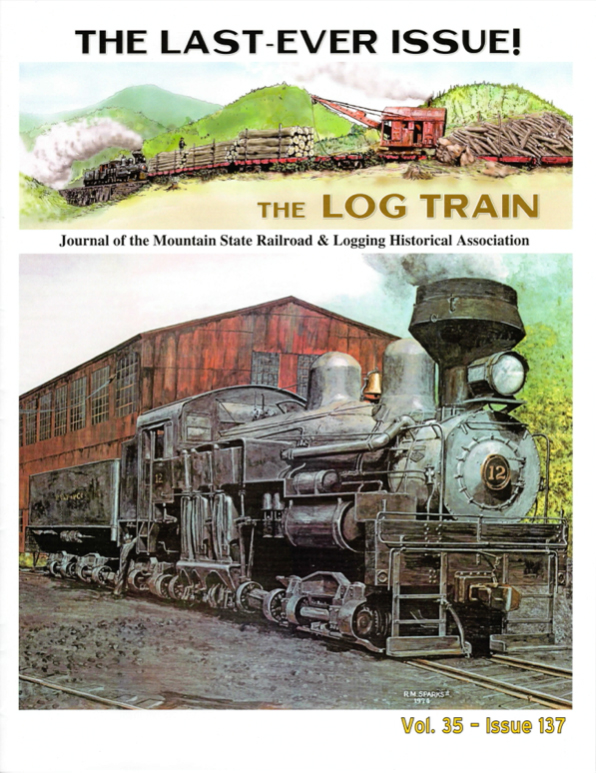
CASS, W.Va. — The Mountain State Railroad & Logging Historical Association, founded in 1982, which played a key role in support of the Cass Scenic Railroad, will conclude operations, its president has announced.
Association president Matt Wilson informed members in a Nov. 24 letter that the organization will become part another group, Friends of Cass — formerly a committee of the Mountain State organization — that will concentrate on preservation of the actual town of Cass, W.Va.
From its formation, the historical association worked almost exclusively to preserve and enhance the railroad assets of the state-owned Cass Scenic Railroad, and that role became superfluous when a private company, Durbin & Greenbrier Valley Railroad, took over Cass rail operations in 2015. Included with the letter was a postcard, addressed to the organization, that allowed current members to vote on dissolution and indicate what should happen to their remaining dues, almost all of which would have been allocated to issues of The Log Train, the association’s journal.
Accompanying the letter and postcard was a copy of the final issue of The Log Train. Its front and back covers were reproductions of two paintings by the late Richard Sparks, one of the association’s original officers, and the bulk of the issue consisted of photographs by the late Russell Baum, arranged in milepost order and colorized by Wilson, the editor. Baum, was the person most responsible for West Virginia’s acquisition of Mower Lumber Co.’s Cass operation in the early 1960s.
Arguably one of the most productive and consequential volunteer railfan support organizations ever, the association accomplished much over its relatively short lifespan after being organized by the legendary photographer and historian John P. Killoran, Cass Scenic’s first superintendent, in 1982. The group’s first big project was Whittaker Camp No. 1, built between 1991 and 1994 and described by Sparks as “a bold step … to create a 1940s logging camp reconstruction having representative shanties, camp cars, log cars, log loader, and an aerial skidder. The project involved volunteers building 1,400 feet of new track, including three switches, and utilizing historic Mower and Meadow River heavy logging equipment that was otherwise just sitting in the yard at Cass.” Whittaker and Bald Knob train riders still have the opportunity to see and explore Camp No. 1.
In 1998, the organization purchased the materials and provided volunteer labor to link the Cass Scenic Railroad with the state’s recently acquired CSX (Western Maryland Railway) Elkins subdivision at Spruce, allowing outside rail access to Cass. That same year, the association provided a down payment for a 90-ton Shay for sale at a San Diego museum; arranged for tractor-trailer transport of the locomotive to Cass; and then dispatched six volunteers to help four Cass Scenic Railroad employees pack and load the locomotive in San Diego. Today, that locomotive operates regularly as Cass Scenic Shay No. 11.
The organization began what would prove to be its largest, most complicated and, ultimately, last big project in the late 1990s: the return of former Middle Fork Railroad three-truck Climax No. 6 to operation as Cass No. 9. Before the association could begin this gargantuan task, the state stipulated that the organization would have to build a dedicated restoration shop. Using donated materials and volunteer labor, the organization completed this new shop, later dedicated to Killoran, by summer 2001. Grady Smith, former Cass Scenic hostler and a highschool shop teacher, took on leadership responsibilities and, over the next 14 years, he and a dedicated, ever-changing group of volunteers completed 80% to 85% of the job before turning it over to the Cass shop crew in 2015. The locomotive operates today for the Cass Scenic Railroad [see “Phoenix rising in West Virginia,” Trains Magazine, January 2020].
After 2015, for a variety of reasons, the group’s membership began to decline, falling from a high of 750 to about 400 today, which prompted the dissolution process to take place over the next few months. Wilson suggests folding the historical association into Friends of Cass may very well be the beginning of something important, and only time will tell.














A single strong organization can be an asset inn historic preservation. Look east at the Friends of the East Broad Top. Or west, at the Friends of Bodie. I can see this being a win-win for Cass Scenic Railroad. And, all who love and depend on it.